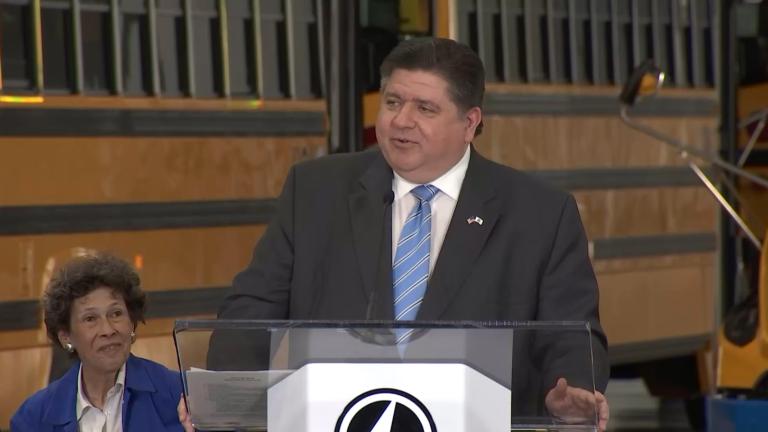 An International Electric MV Series truck is seen on display in Austin, Texas, Wednesday, Feb. 22, 2023. (AP Photo / Eric Gay, File)
An International Electric MV Series truck is seen on display in Austin, Texas, Wednesday, Feb. 22, 2023. (AP Photo / Eric Gay, File)
WASHINGTON (AP) — The Biden administration will propose strict new automobile pollution limits this week that would require at least 54% of new vehicles sold in the U.S. to be electric by 2030 and as many as two of every three by 2032, according to industry and environmental officials briefed on the plan.
The proposed regulation, to be released Wednesday by the Environmental Protection Agency, would set greenhouse gas emissions limits for the 2027 through 2032 model years for passenger vehicles that would be more even stricter than goals the auto industry agreed to in 2021.
The EPA will offer a range of options that the agency can select after a public comment period, the officials said. They asked not to be identified because the proposal hasn’t been made public. The proposed regulation isn’t expected to become final until next year.
Environmental groups are applauding the ambitious numbers, which were first reported over the weekend by The New York Times. But the plan is likely to get strong pushback from the auto industry, which already pledged in August 2021 to make EVs half of U.S. new car sales by 2030 as it moves toward a history-making transition away from internal combustion engines.
Even the low end of the EPA’s 2030 range is 4 percentage points higher than the 2021 goal, which came after strong pressure from President Joe Biden. An executive order signed by Biden set a target for half of all new vehicles sold in 2030 to be zero-emissions vehicles, including battery electric, plug-in hybrid electric or fuel cell electric vehicles.
Biden also wants automakers to raise gas mileage and cut tailpipe pollution between now and model year 2026. That would mark a significant step toward meeting his pledge to cut America’s planet-warming greenhouse gas emissions in half by 2030 as he pushes a once-almost-unthinkable shift from gasoline-powered engines to battery-powered vehicles.
With electric vehicles accounting for just 7.2% of U.S. vehicle sales in the first quarter of this year, the industry has a long way to go to even approach the administration’s targets. However, the percentage of EV sales is growing. Last year it was 5.8% of new vehicles sales.
The EPA tailpipe pollution limits don’t actually require a specific number of electric vehicles to be sold every year, but instead mandate limits on greenhouse gas emissions. That amounts to roughly the same thing, according to agency calculations of the number of EVs that likely would be needed to comply with the stricter pollution limits.
The auto industry likely will need to sell a lot more EVs to meet the requirements. It’s already pushed up the mileage of gasoline vehicles with more efficient engines and transmissions, reducing weight and other measures. Many in the industry say they’d rather spend investment dollars developing new EVs that are likely to dominate the industry in coming years.
Suggesting a brake on the optimistic idea of vast emission improvements simply through rule making, however, the Alliance for Automotive Innovation, a trade association that includes most automakers, said, “Regulatory mandates alone will not address the conditions that will determine the ultimate success of the EV transition.”
Supportive policies such as tax credits for EV purchases and funding of a nationwide network of charging stations are needed, the alliance said in a statement before the EPA rule was announced. EVs have to become more affordable, parts and domestic critical mineral supply chains have to be set up and utility generating capacity must be addressed, the statement said.
Transportation is the single largest source of carbon emissions in the U.S., but it is followed closely by electricity generation.
Environmental groups say stricter tailpipe pollution standards are needed, and provisions of the sweeping Inflation Reduction Act passed last year will help reach the tougher requirements. “Tailpipe emissions pollute the air we breathe and worsen severe weather,” Fred Krupp, president of the Environmental Defense Fund, said in a statement.
The Inflation Reduction Act, a climate and health care law passed with only Democratic votes, has tax credits for electric vehicle manufacturing and for purchases of new and used EVs.
At present, many new EVs manufactured in North America are eligible for a $7,500 tax credit, while used EVs can get up to $4,000.
However, there are price and purchaser income limits that make some vehicles ineligible. And starting April 18, new requirements by the Treasury Department will result in fewer new electric vehicles qualifying for a full $7,500 federal tax credit.
The rules require that certain percentages of battery parts and minerals come from North America or countries with which the U.S. has free trade agreements. Industry analysts say the requirements, announced March 31, could cut the $7,500 credit in half on many vehicles. A smaller credit may not be enough to attract new buyers for EVs that now cost an average of $58,600 according to Kelley Blue Book.
The price is down from $63,500 a year ago as more lower-priced EV models hit the market. Still, EVs are more expensive than the average vehicle sold in the U.S., which costs just under $46,000.








